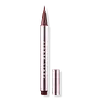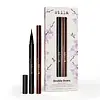Fenty Beauty Flyliner Longwear Liquid Eyeliner Versus Stila Cosmetics Double Down Stay All Day Waterproof Liquid Eye Liner Duo
What's inside
What's inside
 Benefits
Benefits

 Concerns
Concerns

No concerns
 Ingredients Side-by-side
Ingredients Side-by-side

Water
Skin ConditioningStyrene/Acrylates Copolymer
Butylene Glycol
HumectantBeheneth-30
CleansingSodium Polyaspartate
HumectantPhenoxyethanol
PreservativePentylene Glycol
Skin Conditioning1,2-Hexanediol
Skin ConditioningCaprylyl Glycol
EmollientEthylhexylglycerin
Skin ConditioningMicrocrystalline Cellulose
AbsorbentBentonite
AbsorbentAcrylates Copolymer
Sodium Dehydroacetate
PreservativeDisodium EDTA
Sodium Hydroxide
BufferingCI 77266
Cosmetic ColorantCI 77491
Cosmetic ColorantWater, Styrene/Acrylates Copolymer, Butylene Glycol, Beheneth-30, Sodium Polyaspartate, Phenoxyethanol, Pentylene Glycol, 1,2-Hexanediol, Caprylyl Glycol, Ethylhexylglycerin, Microcrystalline Cellulose, Bentonite, Acrylates Copolymer, Sodium Dehydroacetate, Disodium EDTA, Sodium Hydroxide, CI 77266, CI 77491
Water
Skin ConditioningStyrene/Acrylates Copolymer
Butylene Glycol
HumectantBeheneth-30
CleansingSodium Polyaspartate
HumectantPhenoxyethanol
PreservativeAlcohol
AntimicrobialMethylparaben
PreservativePropylparaben
PreservativeSodium Dehydroacetate
PreservativeDisodium EDTA
Acrylates/Octylacrylamide Copolymer
Sodium Hydroxide
BufferingXanthan Gum
EmulsifyingTitanium Dioxide
Cosmetic ColorantIron Oxides
CI 77510
Cosmetic ColorantCI 77266
Cosmetic ColorantIngredients Explained
These ingredients are found in both products.
Ingredients higher up in an ingredient list are typically present in a larger amount.
We don't have a description for Beheneth-30 yet.
Butylene Glycol (or BG) is used within cosmetic products for a few different reasons:
Overall, Butylene Glycol is a safe and well-rounded ingredient that works well with other ingredients.
Though this ingredient works well with most skin types, some people with sensitive skin may experience a reaction such as allergic rashes, closed comedones, or itchiness.
Learn more about Butylene GlycolDisodium EDTA plays a role in making products more stable by aiding other preservatives.
It is a chelating agent, meaning it neutralizes metal ions that may be found in a product.
Disodium EDTA is a salt of edetic acid and is found to be safe in cosmetic ingredients.
Learn more about Disodium EDTAPhenoxyethanol is a preservative that has germicide, antimicrobial, and aromatic properties. Studies show that phenoxyethanol can prevent microbial growth. By itself, it has a scent that is similar to that of a rose.
It's often used in formulations along with Caprylyl Glycol to preserve the shelf life of products.
This ingredient is a preservative with antimicrobial properties. It is the sodium salt of dehydroacetic acid.
It is especially effective at preventing bacterial and fungal growth in low concentrations.
Sodium Hydroxide is also known as lye or caustic soda. It is used to adjust the pH of products; many ingredients require a specific pH to be effective.
In small amounts, sodium hydroxide is considered safe to use. However, large amounts may cause chemical burns due to its high alkaline.
Your skin has a natural pH and acid mantle. This acid mantle helps prevent harmful bacteria from breaking through. The acid mantle also helps keep your skin hydrated.
"Alkaline" refers to a high pH level. A low pH level would be considered acidic.
Learn more about Sodium HydroxideWe don't have a description for Sodium Polyaspartate yet.
We don't have a description for Styrene/Acrylates Copolymer yet.
Water. It's the most common cosmetic ingredient of all. You'll usually see it at the top of ingredient lists, meaning that it makes up the largest part of the product.
So why is it so popular? Water most often acts as a solvent - this means that it helps dissolve other ingredients into the formulation.
You'll also recognize water as that liquid we all need to stay alive. If you see this, drink a glass of water. Stay hydrated!
Learn more about WaterCI 77266 is a high-purity pigment used to create an intense black color in cosmetics. It is made up of fine particles of pure carbon. This ingredient is also often listed as Carbon Black in ingredient lists.
You'll likely find this ingredient in mascaras, eyeliners, brow products, and eye shadow.
In the US, this ingredient can only be used if it meets strict FDA specifications. Certain versions even require batch-by-batch certification after extensive safety evaluation.
In the European Union, this ingredient is permitted as a colorant and classified as a "nanomaterial" based on its particle size (meaning it requires deeper assessment).
The EU Scientific Committee on Consumer Safety (SCCS) has reviewed nano-sized carbon black specifically and concluded that it does not pose a risk to human health when used in cosmetic products applied to healthy, intact skin and formulated to avoid inhalation.
Studies support this regulatory stance. Laboratory studies on nano-carbon black show potential for cytotoxicity and inflammatory effects in immune cells; it is important to highlight these findings are based on in vitro (not done on a living organism) testing or inhalation scenarios rather than normal topical cosmetic use.
Occupational studies involving industrial workers exposed to airborne carbon black have not shown a clear link between cumulative exposure and cancer risk. These findings are not directly applicable to cosmetics; cosmetic formulations bind pigments within creams, gels, and liquids that are not inhaled.
Overall, evidence shows that this ingredient is safe under regulatory guidelines and purity standards, especially when formulated to avoid airborne exposure.
Even with regulatory approval and a long history of use, some consumers might prefer to avoid ingredients that are petroleum-derived or that fall under the “nanomaterial” category.
Choosing whether to use CI 77266 isn’t necessarily about safety alone; it can also be about personal philosophy, comfort level with synthetic versus natural ingredients, and how much weight you place on ongoing research and regulatory oversight.
Makeup is highly individual, and personal preference plays an important role in deciding what feels right for you.
Learn more about CI 77266